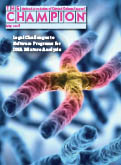May 2018

Probabilistic genotyping software programs analyze complex DNA mixtures. Are these programs accurate? Does the defense have the right to see the software source code?
Articles in this Issue
-
Affiliate News
Affiliate News for May 2018 Champion
-
From the President: Do As I Say, Not As I Do: The Persistent Lack of Diversity in Law Firms
From the halls of elite law schools to partnerships at large law firms, access to corridors of wealth and power has proven elusive for African Americans. Lack of diversity in the profession demands that we hold ourselves accountable.
-
Inside NACDL: Rescue Mission: NACDL Publishes The Trial Penalty: The Sixth Amendment
on the Verge of Extinction and How to Save It
The right to trial, while alive in principle, is on life support in practice. NACDL is determined to revive this right and to confront and reform the systemic factors that have made the risk and cost of a trial so extreme that even innocent individuals routinely plead guilty.
-
Mixing It Up: Legal Challenges to Probabilistic Genotyping Programs for DNA Mixture Analysis
Probabilistic genotyping software is used when DNA evidence is a mixture of contributions from several people, when only trace amounts are collected, or when the evidence has been degraded by elements such as sunlight, moisture, and bacteria. Scientists developed probabilistic genotyping software programs to analyze these complex mixtures. Are these software programs accurate? How can lawyers challenge the admissibility of the programs under Frye and Daubert standards? When should defense counsel bring an “as-applied” challenge?
-
Opening the Black Box: Defendants’ Rights to Confront Forensic Software
Forensic software is used in the criminal justice context to make assertions about the presence and nature of DNA, to deploy police resources to certain areas, or to guide bail and sentencing determinations. Software, however, is far from impartial or infallible. The authors explain why law and public policy require disclosure to the public and independent experts of the software source code and other software development records, including training data sets.
-
Search & Seizure Commentary: U.S. Supreme Court Grants Important Section 1983 Fourth Amendment R
It is intolerable when a detainee is arrested and confined on trumped up charges based on police fabrication of evidence. The U.S. Supreme Court, however, has granted pretrial detainees an important remedy. Manuel v. City of Joliet, Illinois held that when pretrial detention is based on police fabrication of evidence, the detainee may assert a claim for relief under 42 U.S.C. § 1983.
-
The Dawning of a New Era in DNA Profiling
Probabilistic genotyping (PG) is a new computer technology for interpreting complicated DNA profiles. It represents a paradigm shift in the way DNA profiles are interpreted and reported. Attorneys who have specialized in DNA cases by grappling with both molecular biology and statistics will now have to learn to talk about computer science, or at least ask questions about it. They must ask how PG was used in a defendant’s case, and they must make sure that the hypotheses and assumptions run through the PG program were appropriate.
-
What Does Software Engineering Have to Do with DNA?
Probabilistic genotyping software offers an alternative to manual interpretation of DNA data by leveraging computing power. Samples uninterpretable by human methods can now be interpreted by machine. Has forensic DNA analysis embraced software engineering quality assurance practices for probabilistic genotyping systems? Defense attorneys should request materials to gain further insight into a program’s operation (e.g., source code and software development documentation); to assess the verification and validation processes undertaken during development; and to review the calculations performed on DNA samples in the defendant’s case.
-
When DNA Is Not a Gold Standard: Failing to Interpret Mixture Evidence
Dr. Mark Perlin reviews the history of failed DNA mixture interpretation. He begins in 1985, at the start of the genomics revolution, discussing the origins of modern DNA testing. Proceeding in five-year increments, he outlines missed opportunities and policy failures. Perlin offers recommendations to help overcome long-standing DNA interpretation problems.
